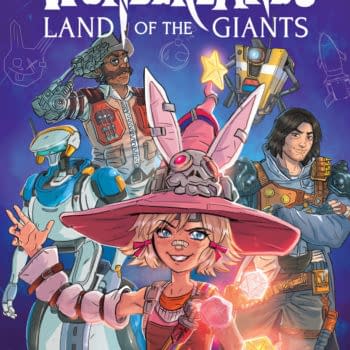Posted in: Comics, Recent Updates | Tagged: Arianna Florean, bbc, Comics, doctor who, Doctor Who: The Tenth Doctor, Elena Casagrande, entertainment, Nick Abadzis, Titan comics
Doctor Who: The Tenth Doctor #2 Reminds Us To Be Both Smart And Imaginative
The BBC television series Doctor Who, now the longest running sci-fi show in existence at 50+ years and counting, has always been smart, though it's a mixed bag of whether audiences acknowledge that. And granted some episodes and seasons have been smarter than others in its long history. The British have long known it was surprisingly intellectual, a younger American audience is starting to figure that out via BBC America. Like the comics medium, or genre comics more specifically, Doctor Who as a show is often judged by its all-ages appeal and funny monster effects as being childish. It's a superficial judgment, as all Whovians know. The fact that you can, as an adult, watch the show with your kids is an added bonus, and quite a multi-generation-embracing bonus that enriches our lives.
Titan's Doctor Who: The Tenth Doctor debuted at issue #1 during San Diego Comic Con, and at the time, I managed to grab a copy and do a brief review. I noted the well-attuned choice of allowing writer Nick Abadzis to work with subject matter he was familiar with, not only from a lifetime of fandom for Doctor Who, but also in its New York setting, apropos for this British-born Brooklynite. But I also noted the multi-cultural appeal of focusing on a Mexican-American family with economic fears and drives as they supported their family business of owning an operating a Laundromat, and their daughter's proxy fears about her own future and whether she'd be confined by her family's aspirations, limiting her own. Gabriella Gonzales is a charming and nuanced character who faces the unveiling of, what in issue #1, seems to be a horror plot-line as devilish creatures emerge from her Laundromat, terrorize her family, and New Yorkers more widely around a Halloween setting.
Issue #1 is all about the feel of a horror comic developing, the need for the Doctor to arrive in order to protect and save as things become more and more frightening for our characters. Issue #2 brings in the "smart" even more fully, with an interesting twist. It teaches us why this is not, in fact, a horror comic, but still feels like one. And it's all a matter of psychology. Our Doctor, first of all, has pitch perfect bouncy dialogue to mirror David Tennant's exuberance, but like Tennant's Doctor also realizes the power of language to defeat fear, and thereby invasive forces. He constantly belittles enemies by referring to them as somewhat grouchy small animals who won't "purr" the way he hopes they will when he manages to establish contact with them. This is partly, no doubt, for Gabriella's benefit, to illustrate for her the power of suggestion and attitude in facing overwhelming odds. Of course, the same goes for the reader.
In Issue #2 there are also lengthy discussions about mental states, fears, and a gradual revelation that this "horror" comic is, in fact, a sci-fi comic as one might expect from a Doctor Who story. Abadzis deftly weaves in themes from Aztec folklore (appropriate to Gabriella's cultural knowledge passed down by her family) and themes from the wider universe of Doctor Who, where we've met many psychologically-attacking predators before. Abadzis' explanations of how the "psychosphere" of earth operates are, in fact, fascinating and encourage an elasticity of mind which I'd call "smart".
Like all good science fiction, it maintains plausibility based upon premises we recognize like evolution, symbiosis, predation, and perhaps most importantly, the fact that we, as humans, don't know every last thing about our own universe, just yet. All of the Doctor's explanations, of course, are delivered in the midst of tense conflict situations, in short bursts that move us closer to understanding what both he and Gabriella are trying to decipher—the roots and causes of the current encroachment of "evil spirits" in New York. To play along with the game-like elaboration of "rules" in this universe, readers are encouraged to be both smart and imaginative. To keep up with the established premises, and imagine that knowing all these things helps, but doesn't fully empower our characters to triumph. We have to imagine a world in which knowing your worst fears are getting the better of you still doesn't eradicate them because they are deep and eviscerating.
Managing to be both smart and imaginative in your reading of this comic means you know it's no longer "really" a horror comic, but still feels like one, and most importantly, it still feels like one to Gabriella. Perhaps that part is about empathy, also a big theme in this issue and storyline. Imagine a young woman who is brought up to fear that she'll lose the ground her family has gained toward prosperity after emigrating, and somehow lose her own personality along the way. It's not that hard to imagine, particularly for American readers, since it's a widespread scenario. Imagine fearing you'll die without achieving your own dreams. That's fairly universal. Imagine not being able to look at your family and friends because they've taken on the aspect of your worst fears—that's a little more of a stretch but certainly works on a metaphorical level.
It's obvious by now that I'm investing a lot of seriousness in this comic issue, and it is there underlining the plot, but that's part of Abadzis' light touch as a writer that he incorporates all of these elements into a fast-paced sci-fi comic while artist Elena Casagrande brings us the realism and facial humor as well as body language from our characters to provide a striking tone we'd recognize as distinctly Doctor Who. Casagrande will bring us the horror here, partly through her rendering of monsters, but also through the reactions of Gabriella, which are highly emotive and convey her psychological state so well. But there's also the wonder that Gabriella manages to capture with colorist Arianna Florean during the Doctor's expositions and when we "see" the psychic principles he's talking about. Together the creative team makes this book both smart and imaginative. And scary, despite knowing better as readers.
That third element is proof of the spell the comic casts, creating empathy, raising questions, and speaking to our own lives. None of this is out of keeping with the show Doctor Who in terms of complexity and impact, and so comics prove again that Doctor Who is one of those rare mythologies that can speak in many registers, for many ages, at the same time effectively.
Hannah Means-Shannon is EIC at Bleeding Cool and @hannahmenzies on Twitter



















